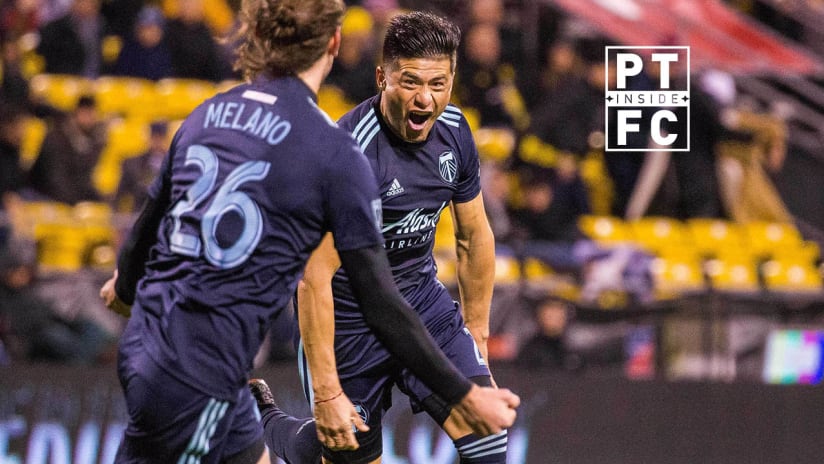The glow from a positive result was always going to carry the day, with the Portland Timbers collecting the team’s first victory of 2019 with a 3-1 result in Columbus, Ohio. Beyond that bottom line, though, one of the more interesting ways of looking at the Timbers’ progression is in terms of the new relationships being formed on the field: Larrys Mabiala'sgrowing new partnership in central defense with Bill Tuiloma; Diego Chara forging a relationship in midfield with Cristhian Paredes; Jeremy Ebobisse and Diego Valeri are looking more like a pure forward tandem than they have in other formations; and Sebastián Blanco seeing the return of Zarek Valentin'sreliability to his side of the field.
Perhaps the most interesting of the evolving relationships, though, is happening on the flank opposite Blanco and Valentin. On the right, fullback Jorge Moreira is firmly establishing himself as one of the team’s starters, something that was expected when he was acquired with Targeted Allocation Money from River Plate shortly before the start of the season. But unleashing his byline-to-byline impact has been a learning process for the Timbers, something that's evolved through lineup and tactical tweaks over the last month.
Enter midfielder Andrés Flores, who saw his first back-to-back starts of the season with his selection against the Crew. In breaking down how the Salvadorian international meshes with his new teammate, you can see why, out of all the midfield options at head coach Giovanni Savarese’s disposal, the normal center-mid option is being asked to help Moreira closer to the sidelines.
The give and take of a more aggressive option
The context for the Moreira-Flores relationship is what the Timbers are trying to do with the former, and what that means for the team defensively. Consider this snapshot, from very early in this Saturday’s game at the Columbus Crew.
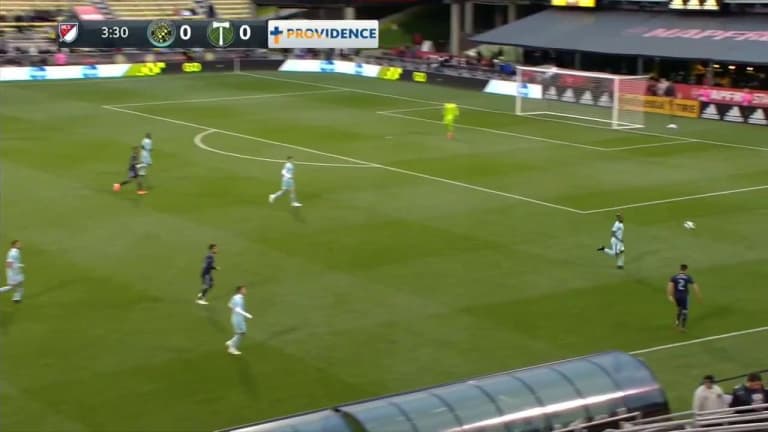
The ball you see at the far right of the frame has just been played from the back line, by Mabiala – a floating, 35-yard try hoping to take advantage of his teammates' high position. While Portland maintained possession, Moreira advanced until he was even with Columbus’ defensive line, a place he tried to occupy up whenever Portland held the ball in midfield. Perhaps as tellingly, Flores – the starter at right midfield, and the player many tactics would have had testing the opposing left back – is about 20 yards deeper than the fullback, likely closing even more ground to his teammate while Mabiala's pass was aloft.
This positioning isn't confined to Portland's build-up phase. It's becoming more common to see Moreira press up against opposing midfielders and fullbacks when the Timbers are without the ball. Whereas most fullbacks will default to the conservative, maybe press up when the rest of the team is set, Moreira appears to be defaulting to aggression first. His nearest teammates are being expected to respond.
Teams can elect to use their fullbacks like this at any time, but the main reason this is working for Portland is Moreira himself. The effort that he is willing to give to cover the spaces ahead and behind means that, while the team doing this still incurs some risk, there’s little danger of the Paraguayan completely abandoning his teammates behind him.
Perhaps the best example of this came early Saturday, when Columbus turned Portland over after Moreira had taken up his high position. Look at the speed with which, coming in from the lower-right hand corner of the frame, below, Moreira gets back into the play. Portland does a good job of containing Columbus’ advance on the far side, but in the interim, Moreira’s doing his best to a normal fullback's spot.
This isn’t a rarity for Moreira. This kind of effort isn’t even isolated to getting back from advanced positions. Look at the work he puts in here, against FC Dallas two weeks ago, to contest a ball that had just left the Portland penalty box.
That work rate is already having an impact on Portland’s tactics, the artifacts of which could be seen this weekend. Below are the passing maps of Moreira, on the right, and his fellow fullback, Valentin. As you can see, there’s a noticeable difference in the length and concentration (and, in fairness to Valentin, accuracy) of each player’s area of impact.
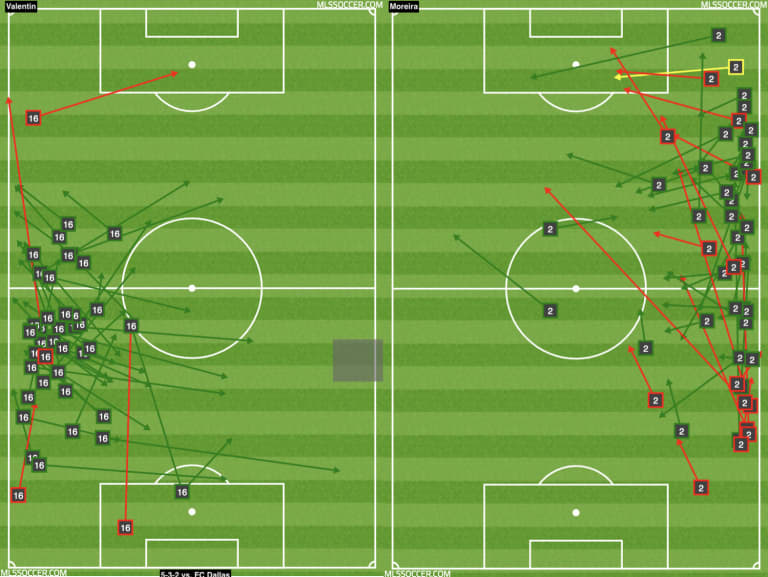
The relationship between Blanco and Valentin is different. Blanco’s value in the attacking phase is indispensable, and with Valentin behind him, there’s more insurance along the back should Blanco decide to explore the middle. Just as Flores and Moreira complement each other, Blanco and Valentin strike a balance, one that sees Valentin stay at home more than his fellow fullback.
The balance on the other side, however, is being tested in new ways, now that opponents know how Portland wants to use Moreira. Just as that usage has benefits, like this huge payoff in stoppage time against Columbus …
… there are also risks that need to be acknowledged.
The reality of being targeted
Down Portland’s left, teams tend to throw numbers at Valentin, trying to test his speed and athleticism in lieu of hoping he’ll be caught out of position. Down the Timbers’ right, however, it’s almost the opposite story. It’s not that teams are hoping to catch Moreira out of position; it’s more knowing that playing higher up the field is part of the right back’s mandate, and that positioning comes with tradeoffs. Those teams know that being out of a typical fullback's position is part of Moreira's job.
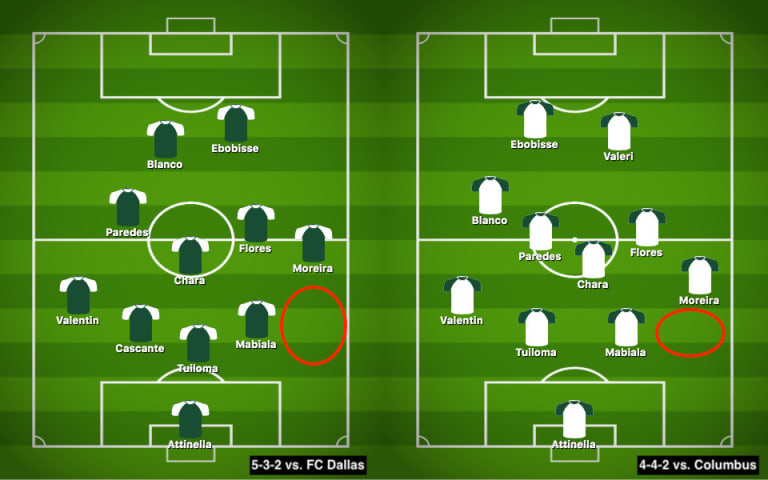
Consider this moment, early against Columbus. The thing to notice isn’t so much the player on the ball, although Federico Higuain is always of note. It’s the place he immediately targets -- lofting a ball into the space behind Moreira – as well as the player who is there.
Pedro Santos, the Crew player closest Mabiala, has been almost exclusively a right-sided player, this year. He’s one of the team’s most important pieces, often forming the link between midfield and attack when Higuain drops deep. At the start of Saturday’s match, though, Columbus had him on the left side, in the space the Timbers’ new tactic leaves vulnerable.
Vulnerable, of course, is a relative term. It’s also universal, as it comes to tactics, with almost any choice a coach or team makes presenting upsides and down. There are positives and negatives to playing three center backs, just as there are two sides to decisions regarding how direct you want to play, or what shape you want to employ. How your tactical choice fits your team’s talent often defines how well it works, not the value of the tactic, itself.
That’s why when you see sequences like this, where FC Dallas uses what appears to be a planned sequence to attack Mabiala's space, the question is less whether Portland’s approach is good or bad. The question is more whether the risk is worth the attacking reward.
The same question holds here, where Dallas left winger Pablo Aranguiz's presence at the far post was not capitalized on by Dallas. If the Timbers are going to be aggressive about how they play on one flank, there may be spaces when (or in this case, if) the ball comes back across.
Like Columbus, Dallas was aggressive about attacking the room behind Moreira. But like Columbus, they were mostly unsuccessful, in terms of the bottom line. Columbus’ only goal came after an aberrational giveaway deep in Portland’s end. Dallas’s goals came from a freak deflection and a penalty kick. While both teams had positive moments going down their left, none of those moments resulted in goals.
Instead, their ventures were more likely to end like this one, where Mabiala employs some strong individual defending when the team’s tactics break down.
Dealing with the challenge
I say “break down,” there, because over the last two games, we’ve seen plenty of examples of how the team wants to protect the space behind Moreira - and it's not by asking Mabiala to do things on his own. It's by giving the center back support from the midfield.
In the example, above, we see both Flores and Chara sprinting, but really, over the course of 90 minutes, the bulk of this work falls on Flores. In the abstract, Flores doesn’t have the athletic qualities you normally associate with a wide midfielder, even if, physically, he’s not that different from Blanco. But there is a reason why much of Flores’ time in Portland has been spent in central midfield. His strengths lie in the middle of the park.
Still, the strengths that make the 28-year-old such a reliable option in the middle also, with a player like Moreira behind him, make him a viable option wide. The intelligence, reliability and responsibility that saw Flores called upon in Seattle during last year’s postseason were also, occasionally, used wide last year, when the team needed his consistency in those spaces. Often, that was as an option off the bench, but with the early-season visit of New York City FC to Providence Park, Savarese gave Flores a start on the right in a vital defensive role.
That defensive value is all the more important when you’re trying to liberate Moreira, with efforts like this – to get back to right back in a moment of transition, against Dallas – justifying the midfielder’s place in the team. Not only does Flores go on a Moreira-esque run to help, but he gets rewarded by being in the right place to play Dallas' speculative ball.
That was when Flores was part of a central three in a 5-3-2 formation. But even wide in a 4-4-2, as Flores was this weekend, the former New York Cosmos’ defensive value comes through, as we see here when he drops back while Moreira comes out for a challenge …
.. or here, when Flores tracks a Columbus runner.
These are the type of plays Flores makes no matter who’s in the lineup, but given how Portland has wanted to use Moreira, they’re becoming more valuable. Just as there’s a symbiosis between Blanco and Valentin on one side of the field, there’s a complementary partnership on the other.
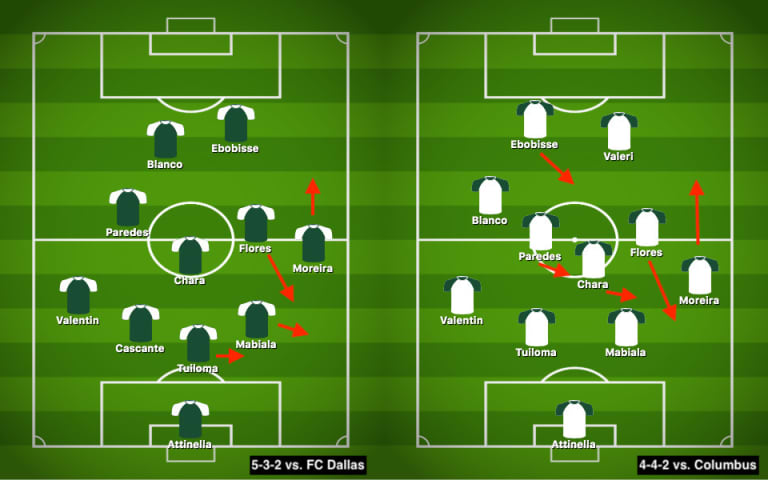
How that partnership evolves, over the course of the season, may be influenced by how Portland evolves as a team. The Timbers are clearly on a tactical journey as it concerns their shape, with the team having already started three different formations this season. As the team evolves, new partnerships may form, and the relationships we see from players like Flores and Moreira may no longer be applicable.
For now, though, the relationship is growing. As a result, the Timbers have looked more dynamic, at both ends of the field. It’s no coincidence that, in the two weeks we’ve seen these new partnerships form, Portland is giving markedly improved performances.

